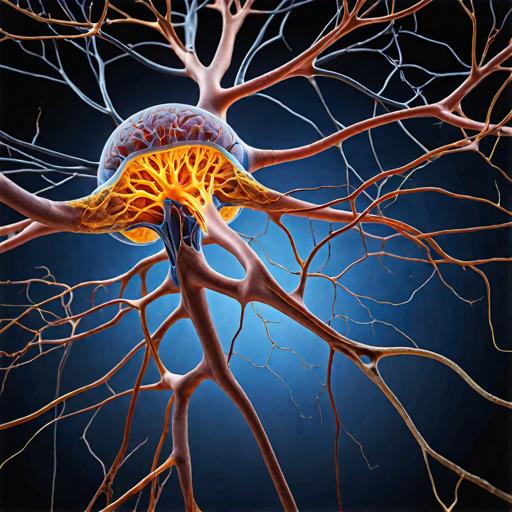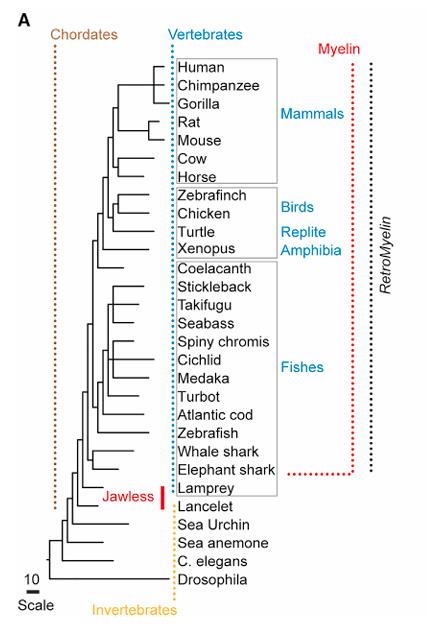Reading Time – 7 Minutes, Difficulty Level – 2/5
As vertebrate organisms have evolved over time, ancient retroviruses have quietly shaped the development of our brains, playing a surprisingly important role in moulding them into the complex organs they are today.
A recent research article published in Cell, on February 15th 2024, found that the emergence of the myelin sheath around axons represents a significant advancement in our understanding of vertebrate evolution. Ghosh et al (2024), found that RNA produced by RetroMyelin, a retrotransposon with roots in retroviral ancestry, plays a vital role in the expression of myelin genes, highlighting their critical importance of retroviral endogenization in the development of vertebrate myelin.
What does this all mean and why is this so important?
Let us start with the importance of myelin and its role in vertebrate evolution.

Neuron with myelin sheath protective layer
Myelin is an essential substance that forms a protective layer around nerve cells; it allows for efficient and fast transmission of electrical impulses. Without myelin, the conduction of nerve impulses is slowed or blocked, resulting in impaired communication between neurons and compromised function of the nervous system (Susuki, 2010). Produced by oligodendrocytes in the central nervous system (CNS), myelin formation, or myelination, occurs as cells stretch out to wrap around multiple axons at once (like trying to wrap electrical tape around a wire multiple times; Fields, 2014).
The development of myelin was likely essential for the expansion and evolutionary success of vertebrates by enabling rapid nerve conduction velocity. It was found to have first evolved in the Ordovician period (~488 millennia ago), and it is known as an evolutionary innovation co-occurring with jaws and main sections of the vertebrate brain (forebrain, midbrain, hindbrain; Bullock et al., 1984). Jawless vertebrates diverged away from other vertebrate lineages preceding the Ordovician period and do not possess myelin, further emphasising its distinct role in vertebrate evolution.
Vertebrates have diversified enormously since the first appearance of myelin; following the bottleneck mass extinction event at the end of the Permian period (also considered the most severe mass-extinction recorded). Fossil records suggest a rise in animal mobility and increased predation pressure among fauna, with an increase in more effective predatory adaptions amongst vertebrate and invertebrate lineages. Simultaneously, crushing jaws and enhanced anti-predatory defences such as spines and armament have evolved, supporting this trend in response to predation pressure (Stiefel et al., 2013).
Evolution optimises biological systems within tissue constraints, as seen in studies on nervous system properties such as cortex wiring and visual system cell numbers. Stiefel et al’s (2013) study hypothesised however, that the role of myelination evolved from improving the energy efficiency of the action potential conduction to improving conduction speed during the Mesozoic marine revolution, following the end of the Permian period, developing a new perception of vertebrate brain evolution. This highlights the delicate relationship between evolution, neural function, and the environmental context in vertebrate brain evolution.
How do ancient retroviruses play a role in all of this?
Endogenous retroviruses (ERVs) are genetic remnants of ancient retroviruses that have become integrated into the vertebrate genome over hundreds of years. Ancient retroviruses are distinct from exogenous retroviruses: exogenous retroviruses actively infect cells horizontally and can move between hosts. Some ERVs date back over 100 million years, sharing genetic similarities with exogenous counterparts, such as long terminal repeats (LTRs) and genes for gag, pol, and env. However, ERVs transmit vertically and have lost their infectivity due to accumulated mutations over time (Hayward, 2017).
Similarly, retrotransposons are repetitive DNA sequences in eukaryotic genomes; some of which have evolved to regulate gene expression despite their ability to move within the genome. ERVs were once capable of producing infectious viral particles, now repurposed to regulate the expression of crucial genes such as myelin basic protein (Mbp), which is essential for myelin formation. This suggests that the endogenization – the process in which genetic material from a virus becomes integrated into the genome of its host organism – of retroviruses has been pivotal in the evolution of vertebrate myelin (Johnson, 2019).

Example of retrovirus
What are the findings of Ghosh et al’s 2024 research?
RetroMyelin, named by Tanay Ghosh in 2022, refers to a gene sequence that is likely a result of an ancient viral infection and is essential for myelin production in vertebrates. RetroMyelin denotes repetitive genetic elements found in multiple copies within a genome, often with high sequence similarity. These sequences in vertebrate genomes may have originated either before speciation, or afterwards through multiple retroviral invasions (Ghosh et al., 2024).

Phylogenetic relationship of RNLTR12-int: hierarchical view of evolutionary relationships among taxa and associated lineages (Ghosh et al., 2024).
Ancient retroviruses played a significant role in shaping vertebrate evolution through various mechanisms. One critical aspect involves the presence of Endogenous Retrovirus 1 (ERV1) within the RetroMyelin sequences found in vertebrate genomes. Studies have demonstrated that disruptions to ERV1 function have profound effects on the activation of the myelin basic protein (Mbp) promoter, highlighting its essential role in controlling Mbp expression. Additionally, RNLTR12-int is found within ERV1, an internal sequence that has been identified across all jawed vertebrates. Ghosh et al (2024), suggests that the widespread presence of RNLTR12-int through convergent evolution highlights the significance of RetroMyelin sequences in regulating Mbp expression.
Moreover, RetroMyelin plays a pivotal role in regulating myelin gene expression by interacting with the transcription factor SOX10, especially evident in rodent models. Experimental studies conducted on zebrafish and frogs further validate the significance of RetroMyelin in regulating the expression of myelin basic protein (Mbp). Evolutionary analysis reveals that certain regions of RetroMyelin sequences are under selective constraints, indicating their importance in myelin regulation throughout evolution. Notably, manipulations leading to reductions in Mbp-promoter-driven EGFP (Enhanced Green Fluorescent Protein) expression provide direct evidence of RetroMyelin’s regulatory function. RetroMyelin acts as a cellular ‘fail-safe’ mechanism, ensuring the maintenance of myelin regulation under adverse conditions, underscoring its crucial role in myelin regulation (Ghosh et al., 2024).
A summary and the relevance of Ghosh et al’s 2024 research
In conclusion, Ghosh et al’s (2024) research sheds light on the essential role of retrotransposons (in particular, RNLTR12-int) in the evolution of myelination in vertebrates. Analysing the gene networks in oligodendrocytes, the study highlights how RNLTR12-int plays a regulatory function in controlling the expression of the Mbp gene, which is crucial for myelin basic protein production, especially across vertebrate species. The study explored the origin and development of RetroMyelin sequences, suggesting that they arose from ancient retroviral invasions of the genome and later adapted for regulating myelination through convergent evolution. Ghosh et al’s (2024) research advances our understanding of the evolutionary mechanisms shaping the development and function of the vertebrate nervous system and brain development. This highlights how, with the presence of many extinct ERVs in the vertebrate genome, viral infections have influenced myelin and vertebrate evolution as a whole.

A former professional badminton player turned STEM enthusiast, Basia holds an MSc in Evolutionary Genetics from the University of Edinburgh.
She’s passionate about all things small, from genes to viruses and other microorganisms, and has a particular interest in viral recombination from a phylogenetic and phylodynamic perspective.








